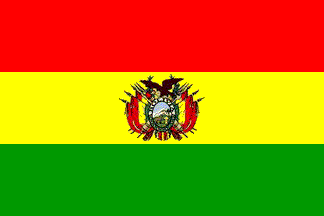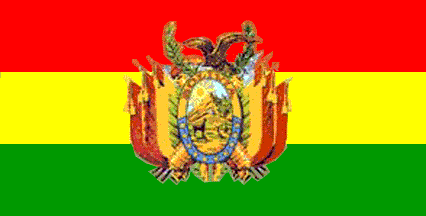
Last modified: 2006-03-18 by antonio martins
Keywords: bolivia | state flag | variation | fertility | bravery | wealth | president | flag | coat of arms: mountain | disc (blue) |
Links: FOTW homepage |
search |
disclaimer and copyright |
write us |
mirrors

According to the construction sheet in the
official
document, the proportions of the Bolivian flag are 7.5:11 i.e. 15:22.
Santiago Dotor, 02 Aug 2004
That’s almost identical to 2:3.
Johnny Andersson, 30 Jul 2004
The Album 2000 [pay00] says:
1. National flag.As far as I am aware, this flag is defined in Decret of 14 July 1888 and has not been changed since (though, possibly there were latter regulations that did not touch this simple flag).2:3
Flag adopted in
1851.10.31,
and confirmed in
1888.07.14.
Jaume Ollé, 01 Jan 1996
As far as the yellow of the Bolivian tricolour is concerned, I
have no official recommendations, however, an official model of the
Naval Ensign shows the middle stripe to be
Pantone 107C.
Christopher Southworth, 04 Feb 2002
In Whitney Smith’s Flags through he Ages and Across the World
[smi75b] the red is said to stand for
the bravery of the Bolivian soldier, green is the fertility of the land
and yellow represents the country’s mineral resources.
Stephan Hurford, 13 Feb 2000
In Webster’s Concise Encyclopedia of Flags, 1985 [mch85a]:
The three horizontal stripes of the Bolivian flag — red, yellow and green — respectively symbolize the gallantry of Bolivian soldiers, the country’s mineral wealth, and the fertility of the land.The meaning of colors on flags is usually given after a flag is adopted; this was probably the case here, as they were derived from earlier flags of Colombia and her liberator, Simon Bolívar
According to [mch85a],
the flag with its present order of stripes was introduced in
1851 but a number of variations
had been used since Bolivia gained independence in
1825.
Jarig Bakker, 02 Jan 2002

The Bolivian coat of arms of
1888 is placed in the middle of the state flag.
Jarig Bakker, 02 Jan 2002
According to a detailed graphic of the arms at an
official
website, their proportions are 13:15 (and apparently
occupying 13/17 the width of the central stripe), plus official Pantone
colours of red 465, Process yellow and green 356.
Christopher Southworth, 02 Aug 2004
The Album 2000 [pay00] have the emblem much larger, about half of the flag hoist. It says:
2. State FlagThe note beside this flag describes that it is also the personal flag for the President of the Republic and and that it is also used in 1:2 variant. What’s the right size of the coat of arms in the state flag, it is prescribed anywhere at all? The book [smi80] indicates the flag use only as2:3

On Bolivian web sites
[f.i., http://www.bolivian.com/bolivia/bandera.html]
there is a new
version of the national flag, which I
believe is only for decorative
reasons. It shows the coat-of-arms stretching
out over all three stripes!
Ralf Stelter, 13 Jun 1999
According to an original piece received from the bolivian
embassy in Paris (and a phone call from them), the flag should
normally be in 2:3 ratio, the flag in 1:2 being an alternative
variant.
Armand du Payrat, 28 Sep 1999
This large emblem verson is kind of unofficial, but ceremonial
version used when “it matters”, if I may put it that way.
Željko Heimer, 11 Mar 2001
My sources (real flags and designs from French Embassy in La Paz
and from Bolivian Consulate in Paris) have various sizes of coat of
arms in flag.
Armand du Payrat, 12 Mar 2001
.gif)
[smi80] shows the coat of arms
set in light blue disk of diameter equal to yellow stripe height.
Željko Heimer, 11 Mar 2001
My sources (real flags and designs from French Embassy in La Paz
and from Bolivian Consulate in Paris) concurr to no blue disk.
Armand du Payrat, 12 Mar 2001

The note beside the state flag in the Album
2000 [pay00] describes that it is
also the personal flag for the President of the Republic and and that it
is also used in 1:2 variant.
Željko Heimer, 11 Mar 2001
.gif)
The Bolvian State flag includes the coat
of arms.
Kristian Söderberg 04 May 2003
The coat of Arms of Bolivia has now 10 stars, for all
departments, including the lost maritime
one.
Armand du Payrat, 10 Feb 1999
Calderón & Cortéz [a2d01] says that:
Mark Sensen, 11 Mar 2002
The tenth star was added to the coat of arms in times of president
Gral. René Barrientos Ortuño (1966-1969). It was pretension of Bolivia to
seaside department of Litoral lost in war of 1879.
Source: Velásquez, 1983 [vzz83].
Victor Lomantsov, 09 Mar 2002
The book [smi80] still shows the 9-star
version (on blue disc).
Željko Heimer, 11 Mar 2001
In Webster’s New International Dictionary of ca. 1920
[wbs24], I found the a Coat of Arms:
Mountain to the right and two hills to the left. To the right of
the mountain is a tree. Left under the hill is an alpaca in red (running
colors). Left to the top of the mountain is a golden sun on a sky-blue
field. The shield is surrounded by a band; upper half is in gold with
black inscription "BOLIVIA"; lower half in light blue with nine
5-pointed stars.
Left and right to the shield are hanging flags (red, yellow and green).
On top of the
shield is a bird, which looks very much like a redbrown eagle. (Wings
are comparably too short for a condor).
Jarig Bakker, 25 Jun 1999
The official arms has a oval border, yellow in the upper part with caption
"Republica Boliviana" (red, also known with caption "Bolivia"), and blue
in the lower part with six five pointed yellow stars. In centre is a llama of
Andes, an alpaca, a small andine house (not quoted in the law), a palm, a sun,
a mountain (the Potosí), a prairie and a sheaf of weath. The background must be
white in the upper part and green in the lower part.
Jaume Ollé, 11 Jun 1999
In Webster’s Concise Encyclopedia of Flags, 1985 [mch85a]:
The arms consist of an oval shield depicting a landscape with a stylized illustration of Mount Potosi in bright sunshine and, in the foreground, a South American alpaca, a breadfruit tree, and a wheat sheaf, with a forest and a house in the middle distance. The upper golden border of the oval bears the name of the country BOLIVIA in red letters, and the lower blue border is charged with nine gold five-pointed stars representing the departments of the country. Behind the oval there are two crossed cannon barrels, six Bolivian flags, four rifles, a Phrygian cap of liberty, an Inca battle-axe and a laurel wreath; perched on the oval shield is an Andean condor.Jarig Bakker, 13 Feb 2000
A star was added to the national coat of arms in 1961 to represent the department of Pando. From Luis Eduardo Arce Cortéz & Ivette Durán Calderón’s Tratado internacional de vexilología y manual cívico del Boliviano [a2d01]:
Ley del 10 Noviembre de 1961
Escudo de ArmasAñádase una estrella en representación simbólica de la creación del Departamento de Pando
Víctor Paz Estanssoro
Presidente Constiticional de la RépublicaPor cuanto el H. Congreso Nacional ha sancionado la siguiente ley:
El Congreso Nacional decreta:
Art. único.- Agrégase al Escudo de Armas de la Nación, una estrella más en representación simbólica de la creación del departamento de Pando. Comuníquese al Ejecutivo para los finos consuguintes.Sala de Sesiones del H. Congreso Nacional
La Paz, 26 de octubre de 1961.